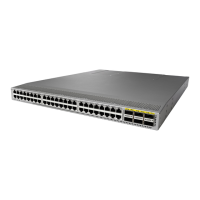Send comments to nexus3k-docfeedback@cisco.com
-SM-113
Cisco Nexus 3000 Series NX-OS System Management Command Reference
OL-29557-04
Chapter System Management Commands
logging server
logging server
To configure a remote syslog server at the specified hostname or IPv4/IPv6 address, use the logging
server command. To disable the remote syslog server, use the no form of this command.
logging server host [severity-level] [facility facility | use-vrf {vrf_name | management}]
no logging server host [severity-level] [facility facility | use-vrf {vrf_name | management}]
Syntax Description
Command Default The default outgoing facility is local7.
The default VRF is management.
Command Modes Global configuration mode
Command History
host Hostname or IPv4/IPv6 address of the remote syslog server.
severity-level (Optional) Number of the desired severity level at which messages should be
logged. Messages at or numerically lower than the specified level are logged.
Severity levels are as follows:
• 0—emergency: System unusable
• 1—alert: Immediate action needed
• 2—critical: Critical condition—default level
• 3—error: Error condition
• 4—warning: Warning condition
• 5—notification: Normal but significant condition
• 6—informational: Informational message only
• 7—debugging: Appears during debugging only
facility facility (Optional) Specifies the outgoing facility. The facility can be one of the
following: auth, authpriv, cron, daemon, ftp, kernel, local0, local1,
local2, local3, local4, local5, local6, local7, lpr, mail, news, syslog, user,
uucp
The default outgoing facility is local7.
vrf vrf_name (Optional) Specifies the virtual routing and forwarding (VRF) to be used in
the remote server. The name can be a maximum of 32 alphanumeric
characters.
management Specifies the management VRF. This is the default VRF.
Release Modification
5.0(3)U1(1) This command was introduced.

